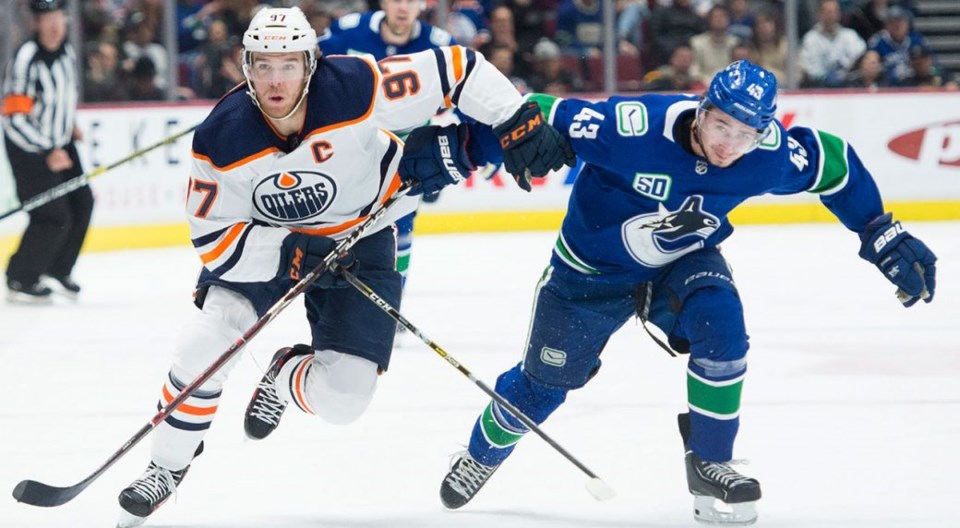Pacific Pool Party is a weekly column where Ryan Lambert breaks down (and belittles) the battle for the playoffs in the Pacific Division.
Though a lot of people understandably wrote off the Edmonton Oilers more than a month ago, things have changed a lot since the calendar flipped to 2020.
Despite their appearance as a two-player team with some serious depth issues, the Oilers have just one regulation loss since New Year’s Eve and now stand second in the Pacific Division. That loss was the infamous Tkachuk/Kassian dust-up game on January 11th, and they’ve won plenty both before and since, despite a five-game road trip and fairly impressive slate of opponents.
So the question is what the Oilers actually “are.” Could they be as good as they’ve shown in the last month-plus? Almost certainly not. Are they as bad as the 8-12-2 stretch they went through from mid-November to late December? It’s a longer runway but here, too, it’s doubtful.
(Editor’s note: Something about that mid-November to late December slide followed by a tremendous run seems vaguely familiar from a Vancouver perspective.)
It strikes me as a bit reductionist to simply say the Oilers are about as good as their roughly 98-point pace, but that seems like the neighborhood we should see them in, at least at first glance.
I’ve written before that the Oilers are probably greater than the sum of their parts simply because two of those parts are Connor McDavid and Leon Draisaitl. In this ultra-successful stretch, McDavid has been on the ice for 22 goals, Draisaitl for 27, and the team has 52 overall.
What’s interesting, though, is that this is all coming as the Oilers have shaken things up: It’s no longer the Draisaitl/McDavid show when the top line is on the ice and an absolute bloodbath when they’re off. That’s because they finally found a solution that works for a second line: Draisaitl between Ryan Nugent-Hopkins and Kailer Yamamoto. It is not a coincidence that Yamamoto was recalled on the same day this hot run started; he was paired with Nugent-Hopkins and Draisaitl almost immediately and they found instant success and chemistry.
Yamamoto has been a revelation since getting called up from Bakersfield and has 5 goals and 10 points in 11 games.
While Nugent-Hopkins is a decent No. 2 center option for a lot of teams, that’s not the case for the Oilers, because he basically had no help from whoever his wingers happened to be on a given night. Putting him on the wing with Draisaitl gives Draisaitl two legitimate wingers, and that finally gives head coach Dave Tippett actual options.
Now the Oilers have Connor McDavid, who’s always going to score, between Josh Archibald and Zack Kassian (yeesh), and Draisaitl has support from his two new buddies, so he’s not just drowning away from McDavid.
The argument against the Oilers being legitimate this season was always predicated on their lack of options when the McDavid/Draisaitl line came off the ice. Previous experiments in breaking them up ended in disaster. But now, Yamamoto and Nugent-Hopkins finding this insta-chemistry with Draisaitl gives them two legitimate scoring lines all of a sudden, and it’s no coincidence that the Oilers have the third-best expected-goals percentage in the league.
It’s great to have two mega-talents putting up 60ish percent of all expected goals when they’re on the ice, but when the other 40 minutes of the game happen and that number is closer to 38 percent, that’s a problem.
If it’s two lines playing 17-plus minutes each at 60ish percent, though? Well, that’s a very different issue altogether. Especially because elite talent tends to outperform xG numbers, especially in xGF. And then if you’re in a bind late, you always have the option of putting two of the absolute best players in the world back together temporarily to get a goal.
Obviously, the Oilers’ roster still has problems. McDavid’s wingers are, again, Archibald and Kassian (at least they can both vaguely keep up with McDavid, I guess). Their bottom six is largely a collection of has-beens and never-will-bes. Their defence is serviceable but probably ranks around the middle of the league as a six-man unit on its best days. Their goalies are Mike Smith and Mikko Koskinen, neither of whom grades out as anything more than “adequate.”
And none of that matters much anymore with these two lines absolutely speedbagging opponents for the last five weeks. Will the team as a whole keep shooting 14 or 15 percent, as it has since this stretch began? No. Will McDavid and Draisaitl have goals-for percentages starting with “seventy-” or “eighty-” to boot? No.
But can this team start winning a lot of 4-3 and 5-4 games with these two separate high-quality scoring lines? As long as they hold together — which isn’t a guarantee, of course — the answer is yes. We don’t really have a lot of information on what Yamamoto is, and he might just be on a huge bender right now, but if he’s even in the realm of this kind of contributor riding shotgun with Nugent-Hopkins and Draisaitl, that will serve the team well over the next few months.
If nothing else, that makes the top of the Pacific Division much dicier to predict. Edmonton is three points back of Vancouver with a game in hand, and one has to assume their pace is going to improve as long as the Yamamoto experiment holds together. That’s also bad news for trailing Vegas and Calgary, who suddenly need to pull out even stronger performances over the last third of the season.
That is, I guess, the luxury of having two all-world talents, and now, more than one other guy who can actually support them. What a world.
Ryan Lambert is on Twitter @twolinepass.





